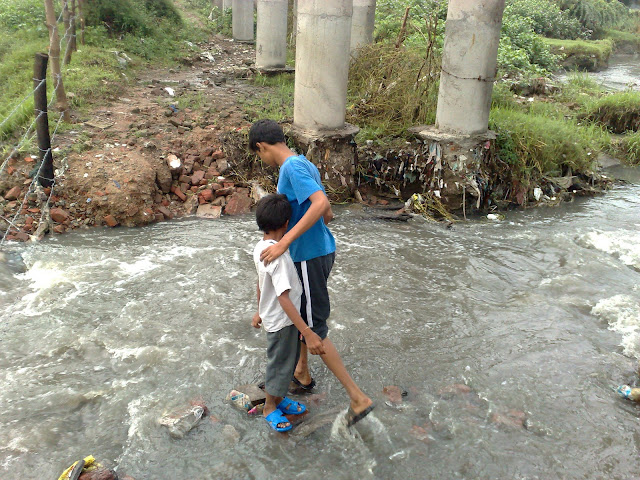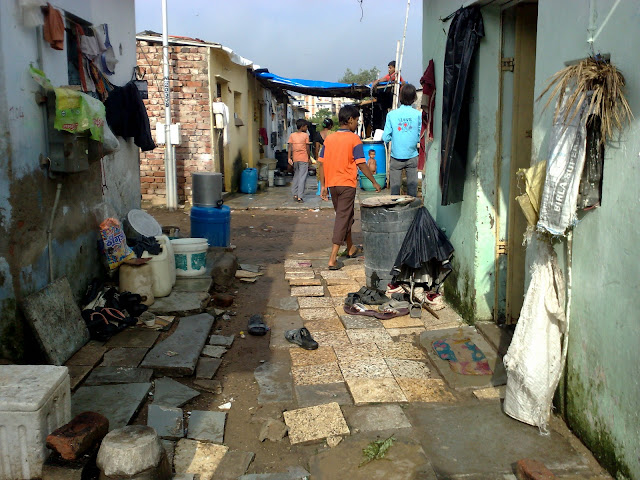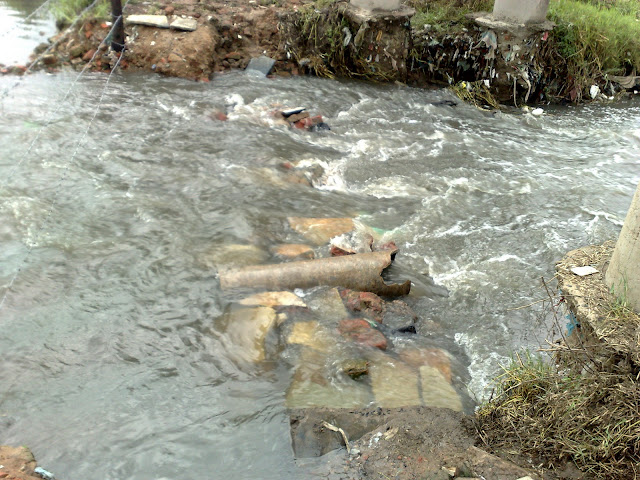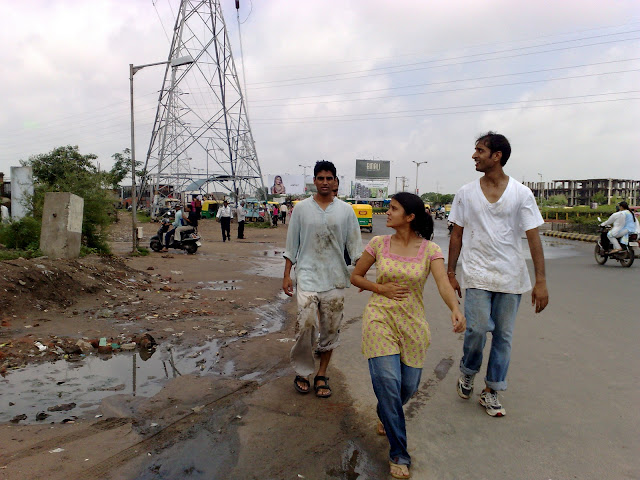Multivariate Bridges and Metaphysical Mangoes
Context: The below was originally a blog post from an American living in India, a grad student finishing his PhD in Computer Science from Stanford on using Information Technology in the developing world.
 Last weekend, my friend Nimo came to the group with a problem. On the main pathway between a slum in Ranip and Manav Sadhna, a stream had built up due to the persistent rain we've been getting lately. The stream was pouring through the passway from a storm drain that also contained waste water from the locality. The issue was that kids from the slum trying to get to MS had to cross the stream daily or more with no proper way to walk, and between the water's filthiness and the pressure it was rushing with, it was becoming a dangerous situation. Rumor even had it that one kid had climbed a parallel drinking water pipeline to cross the stream and had fallen from a considerable height.
Last weekend, my friend Nimo came to the group with a problem. On the main pathway between a slum in Ranip and Manav Sadhna, a stream had built up due to the persistent rain we've been getting lately. The stream was pouring through the passway from a storm drain that also contained waste water from the locality. The issue was that kids from the slum trying to get to MS had to cross the stream daily or more with no proper way to walk, and between the water's filthiness and the pressure it was rushing with, it was becoming a dangerous situation. Rumor even had it that one kid had climbed a parallel drinking water pipeline to cross the stream and had fallen from a considerable height.
So our Sunday project was to go down to the stream and fashion together a safe walkway across the water. Nimo had prepared 3 sandbags that he figured we could place over a bed of well-placed rocks that we could collect from around the stream. Seemed straightforward, but that's about where it stopped being so simple.
We got to the slum in the morning around 8. Our team consisted of myself, Nimo, Anjali, Jeego, Jesús (a volunteer from Spain working with MS through Australia-based Arichtects Without Frontiers), and Sachi. We also recruited some of the local kids to help. They were overjoyed to see Nimo and Anjali, I think half of them thought we were just there to play. We were, but the game was going to be carrying around heavy rocks and wading around in filthy water for a few hours.
 When I got down to see the stream for the first time, my mind turned quiet. This was not going to be a rinky-dink Sunday morning project. This was a serious stream, clearly a hazard for a kid, an adult carrying supplies or vessels, animals, or any other entity trying to cross. Building a durable bridge was going to require some smarts and creativity. That was my first reaction. My second reaction was that I wish Jay was here, because he has a lot of smarts and creativity, especially for engineering puzzles like this. If he was there he would have MacGyver'd the optimal solution. Alas.
When I got down to see the stream for the first time, my mind turned quiet. This was not going to be a rinky-dink Sunday morning project. This was a serious stream, clearly a hazard for a kid, an adult carrying supplies or vessels, animals, or any other entity trying to cross. Building a durable bridge was going to require some smarts and creativity. That was my first reaction. My second reaction was that I wish Jay was here, because he has a lot of smarts and creativity, especially for engineering puzzles like this. If he was there he would have MacGyver'd the optimal solution. Alas.
At this point, the elements of a multivariate calculus problem began revealing themselves. First, there was the practical issue of our bridge solution. Clearly we needed something that was sturdy and safe. Couldn't be too high in case someone falls, can't be too low to be pounded by the water. And clearly we had no money, so it had to be cheap. A local man living right next to the stream said straight away, rocks and sandbags were going to fail. The pressure of the stream built up in the afternoon, and with any decently hard rain the structure would get washed away. He even pointed out the remains of previous ill-fated attempts scattered on the banks a bit down-river. Go ahead, he said, spend your morning doing a bunch of heavy, dirty lifting. It will be a waste of your time.
 I agreed, we needed a better solution. Talking to some of the local boys, I found out that there was a cache of wood in the slum, kept by one of the kid's fathers. I went with two of the boys to go to check it out. We got to the home and on top of the roof was piles and piles of long, straight bamboo. Now we're getting somewhere, I thought. There were even some ladder-like structures fashioned out of the bamboo with some twine. Build two of those babies, I thought, lean one off of each bank, anchor where they meet down in the middle of the stream with rocks and sandbags, and you could have a simple v-style bamboo bridge.
I agreed, we needed a better solution. Talking to some of the local boys, I found out that there was a cache of wood in the slum, kept by one of the kid's fathers. I went with two of the boys to go to check it out. We got to the home and on top of the roof was piles and piles of long, straight bamboo. Now we're getting somewhere, I thought. There were even some ladder-like structures fashioned out of the bamboo with some twine. Build two of those babies, I thought, lean one off of each bank, anchor where they meet down in the middle of the stream with rocks and sandbags, and you could have a simple v-style bamboo bridge.
I really wanted to just take the wood down with the boys and be on our way, but of course it would not be so simple. Vinubhai, the kid's father and keeper of the bamboo, had just gotten back home and needed to know what was going on. I explained what we were doing, and he seemed to generally be on board with using the bamboo. But, he said, I had to go over and get permission with his brother a few houses down. So I go over there, and there's more smiling and explaining. Then I get sent back to Vinubhai, who has now decided to come with us and assess the stream himself. And with him a third relative joins. So we head back down, no bamboo in hand, but more people from the slum. New variable: the community must be bought in.
Vinubhai looks things over and agrees that bamboo could work, but we would need longer pieces to stretch all the way across plus 5 meters of additional slack for support, proper fastening, mounting, etc. Then the money issue. Who's paying? And now that money is in the conversation, more expensive solutions are tossed out. What about a steel-based solution? Which introduces another variable: bridge security. If we use steel, someone will attempt to steal it, it fetches a high resale price. Even if you try to anchor it, theft will find a way. So, the bridge will require spending, but it can't be too expensive. Then another variable: animals. If they step on your bamboo bridge, it will surely collapse. You have to keep room for animals to cross separately, or build with the assumption that cows will be passing through as well. Then another variable: longevity. Is this a short term or long term solution? Maybe we just build something to last the winter, and then take the time to raise money to get professionals to come in and build something legit. But then what if that doesn't end up happening? We're stuck with a short-term bridge for the long term. Then another variable: environmental-friendly solution. If we get professionals to do something with concrete, it's not as sustainable as bamboo. Earth-impact should be accounted for. Then another variable: community engagement. How many people do we want to involve? The more that come to the table, the more opinions and less chance of consensus. But you need people in the community to feel a sense of ownership over the solution. Ideally they should contribute to it themselves. But then if it gets to be too big of a deal, and the government or media catches wind, then the bureaucracy machine could get involved, and that could lead to more overhead and delays.Peepli live. And then people will propose more and more elaborate solutions, requiring more money and deeper involvement from more people. Didn't we already bring up the money variable? Vicious cycle. Wait a minute, what are we doing here again? Building a simple bridge across a simple stream to simply walk!
At this point our team was less interested in vetting the issues and more interested in doing something, so we cut all the crap and started gathering rocks. As big and as many as possible from the surrounding area. Meanwhile Jesúsembedded in the stream to receive the rocks from an assembly line of workers and fashion them into a sturdy foundation. This was grueling work, standing knee-deep in rushing water ripe with bacteria and fecal matter. Once we had gathered most of the big rocks around, we found discarded burlap sacks and filled them with smaller rocks. Then, one of the youngsters came up with a genius idea... lead pipes! There were a few laying around the banks, and a few that we dug up. The nice thing about the pipes was that they don't absorb the full force of the water pressure. You set them parallel to the stream so water can just rush through. So the bridge took the form of a rock/pipe medley, and was looking great. One more pipe and a bunch more rocks and we may have something. Until...
standing knee-deep in rushing water ripe with bacteria and fecal matter. Once we had gathered most of the big rocks around, we found discarded burlap sacks and filled them with smaller rocks. Then, one of the youngsters came up with a genius idea... lead pipes! There were a few laying around the banks, and a few that we dug up. The nice thing about the pipes was that they don't absorb the full force of the water pressure. You set them parallel to the stream so water can just rush through. So the bridge took the form of a rock/pipe medley, and was looking great. One more pipe and a bunch more rocks and we may have something. Until...
Another local man living near the stream arrived on the scene and took particular exception to us using the pipes. These pipes belong to me, he claimed, you cannot use them like this. And then just like that, as we are working on one side of the bridge, he wades into the stream and dislodges a pipe from the other side, sending it rushing down the stream. Later we are able to talk him down and even get him on our side to help build the bridge according to (of course) his own pet design, but the damage had been done. Now we're scrambling to make due without the pipes, racing against the rising tide as the morning gets older.
 And we are losing the race. The rocks don't seem to be holding well enough with the rising tide, and the sandbags instantly get punctured and flimsy once we set them down. In the end we had something of a bridge, but it seemed mildly worse than whatever was there for walking before we got there. An illusion of a strong bridge is more dangerous than no bridge. So along the bridge we did our best to dislodge what was loose and strengthen what was strong, and left it at that.
And we are losing the race. The rocks don't seem to be holding well enough with the rising tide, and the sandbags instantly get punctured and flimsy once we set them down. In the end we had something of a bridge, but it seemed mildly worse than whatever was there for walking before we got there. An illusion of a strong bridge is more dangerous than no bridge. So along the bridge we did our best to dislodge what was loose and strengthen what was strong, and left it at that.
There was much food for thought from this experience, but I'll focus on two personal key takeaways. The first is the insight that in life there are rarely simple solutions, and there are a lot of complicated problems that are deceiving. I came in with the expectation that building a bridge is a self-contained problem, mostly involving engineering the right physical solution. But really it was a people, money, motivation, even political problem, at least as much as it was technical.
Second takeaway was a question to ponder: When performing actions, is the right intention enough? We came to the slum on Sunday morning with the more or less pure intention of serving the community in a small way. The problem was we were carrying a slingshot into a war where everyone else had Uzis and grenades. In retrospect it was naive to think we could come in with a few sandbags, a shovel, a bucket, and a few hours of time and expect to come up with a satisfactory solution. I told our team how I thought we should either have come with everything we would ever need (hundreds of sandbags, thousands of long thick bamboo, rope galore, a concrete machine, a suitcase of cash) or nothing at all (just to observe and understand, to come back later with proper preparation). Anything in the middle would be half-hearted. And what about the fact that we walked away leaving the situation we came to fix 5% better off, plus-or-minus 10%? This was my mind's competitive, ambitious, practical impact side, yelling impatiently.
But then there is a case to make for simply acting with a pure intention. This is the long-view, million-lifetimes side of my mind, calmly whispering. Sure we only brought a slingshot, but we showed up to fight with spirit and fearlessness, didn't we? It's the William Wallace way. And just our presence there surely mattered. We showed ourselves and others around that we cared. The ripples that pure-intentioned presence creates is hard to either capture or predict. One of those kids with us, taking a lesson in determination and seeing things through, could have gotten the inspiration to do so. Or a community member, observing how much outsiders care, could start caring more herself and eventually act.
 Where do these two sides of mind reconcile? I think the middle ground is paved by qualities I have come to learn about and appreciate through meditation: patience and persistence. There is not a quick-fix solution here - be patient. You want there to be a successful outcome, you don't want to develop a half-heart-ing habit - be persistent.
Where do these two sides of mind reconcile? I think the middle ground is paved by qualities I have come to learn about and appreciate through meditation: patience and persistence. There is not a quick-fix solution here - be patient. You want there to be a successful outcome, you don't want to develop a half-heart-ing habit - be persistent.
On that Sunday morning, though we weren't able to bear fruits, we did plant seeds. As the meditation teacher S.N. Goenka says, you can't plant bitter neem and expect to get sweet mangoes. You reap what you sow. One thing I know for sure we accomplished that day: we planted a forest of metaphysical mangoes.
This article is reprinted here with permission from the author, Neil Patel. Neil is the co-founder of Awaaz De, a social enterprise recently named a laureate of The Tech Awards 2011, one of 15 global innovators recognized each year for applying technology to benefit humanity and spark global change. Awaaz De is on Facebook and Twitter.
